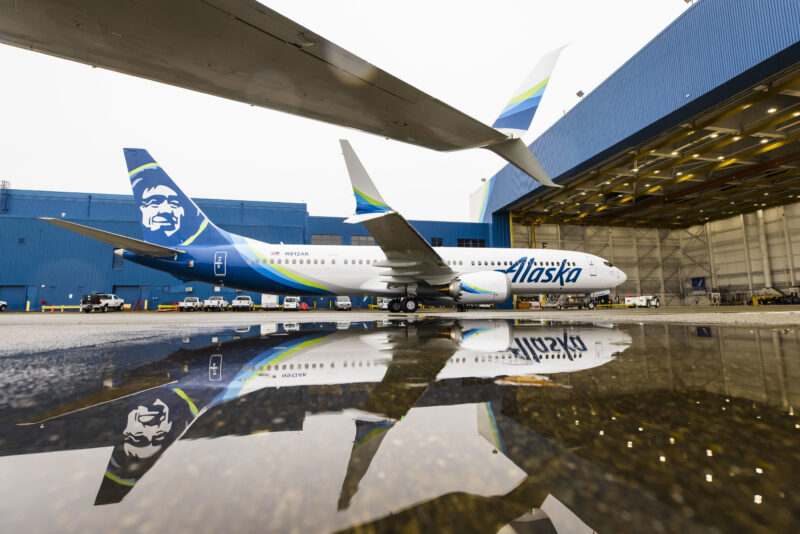Boeing’s 737 Max Gathers Momentum – At Last
As India reportedly considers lifting its order grounding the jets, Alaska Air and GOL both add to their orders
August 24, 2021

Photo: Courtesy of Alaska Airlines
As more nations grant approval for the 737 Max to fly and more airlines add to Boeing’s order books, the latest iteration of the world’s most widely used passenger jet is staging a comeback. Alaska Airlines has announced that it is exercising options early on 12 Boeing 737 Max-9 aircraft, while GOL Linhas Aéreas Inteligentes has signed agreements for 28 additional Max-8s.
By moving the options into the firm commitment column, Alaska brings it total firm order of 737-9s to 93 aircraft, five of which are currently online. Meanwhile GOL will now end 2021 with 28 MAX aircraft, and by the year-end 2022 will have taken delivery of 44 of the jetliners, constituting 32 percent of the carrier’s total fleet.
Nat Pieper, Alaska’s senior vice president of fleet, finance and alliances, said the aircraft “are a prudent, long-term investment in our business that we can make while simultaneously maintaining our strong balance sheet.”
According to airline data provider Cirium and Boeing’s own count, there are currently 346 737 Max aircraft being operated by 30 carriers globally. And that number appears set to grow, as India’s aviation officials may soon greenlight the return of the aircraft to service, according to reports from Bloomberg News.
The approval of India’s safety regulators would leave only China as the last major world market where Boeing’s workhorse jetliner is still grounded – and Boeing is already conducting test flights of the aircraft for Chinese authorities there.
Currently, the largest operators are all in the US: Southwest Airlines with 68, American, which flies 41 of the planes, and United which includes 35 in its fleet.
Reluctant Fliers
As Max sales take off, airline industry fears about passengers being reluctant to board the jet are proving to be mostly groundless.
However when it was first introduced, Boeing’s bet on the single-aisle aircraft market got off to a less than auspicious start. Following two deadly crashes that took the lives of 346 people, the Max was grounded from March 2019 through November 2020.
The two accidents were blamed in part on the aircraft’s Maneuvering Characteristics Augmentation System (MCAS). Input from a malfunctioning sensor caused the MCAS flight control system to mistakenly detect a stall, forcing the nose down and leading to a crash.
The accidents produced a ripple effect throughout the aviation industry. During the 20-month grounding, not only did the Max’s software and training get a major overhaul, Boeing management underwent major changes and Congress revamped the entireprocess by which the Federal Aviation Administration certifies new aircraft.
However the longer the 737s sat on the ground gathering dust, the more concern grew in the industry that passengers would refuse to take the risk on an aircraft which had received so much negative press. According to surveys at the time, as many as 70 percent of travelers said they would be reluctant to fly on a Max once it was re-certified.
In November 2020, the FAA rescinded its ban on the aircraft, clearing the way for airlines which had already taken delivery of the new 737s to resume operations. The first of these was Brazil’s low-cost carrier GOL, which began Max flights in December 2020, followed soon after by American Airlines.
Now that the jetliner has been back in service for the better part of a year – and a year in which travel has been decimated by COVID-19 – the traveling public appears to have taken the return of the Max in stride, according to the airlines.
“From the first day of flying to now, we just don’t see anyone having any concerns at all,” American Airlines chief operating officer David Seymour told industry publication Airline Weekly. Despite the fact that the carrier offers passengers the ability to switch to non-Max flights, few if any fliers have taken advantage of the option, he added.
Two other Max operators, Alaska Airlines and Ryanair, report that no passengers have taken advantage of the option to change to a non-Max flight for free. At Copa Airlines, which flies 13 of the 737-9s, vice president of flight operations Captain Bolivar Dominguez is quoted by Aviation Weekly as saying travelers did not have “any restraint” to fly on the plane. “People’s minds are somewhere else and not on the aircraft,” he added, a nod to travel in the time of COVID-19.
Good News for Boeing – Mostly
“The simplest referendum I can give you is what we did in May,” Alaska Air’s Pieper told the aviation publication. “We went and doubled down for 13 more.” That was in May; with the conversion of the latest options, Alaska plans to fly 65 737-9s by the end of 2023.
In addition to Alaska Airlines and GOL, Aeromexico, Ryanair, Southwest and United have also beefed up their 737 Max orders since the plane returned to the skies. By far the largest of these is United, which made news with its order for 200 of the single aisle airliners: 50 of the 737-8s and 150 of the -10 variant. Southwest, too, has bumped up its Boeing deal, adding 140 new order so far this year.

Airlines in general have used the pandemic-induced slowdown in travel to reshape their fleets, moving toward more cost effective and fuel efficient aircraft, strategies that play into the Max’s main selling points – improved performance and efficiency gains.
For example, GOL says speeding up its fleet transformation with additional 737 Max-8s is expected to reduce the company’s unit costs by 8 percent in 2022.
“We are accelerating our fleet transformation plan in anticipation of a strong recovery in travel in the post-pandemic environment,” said Paulo Kakinoff, GOL’s CEO. “The 737 Max positions GOL more competitively for growth through the expansion of routes and destinations, while also enhancing the company’s value for all stakeholders through increased efficiency.”
The continued growth in the 737 Max order book is good news for Boeing, which took a serious hit in 2019 and 2020 when airlines dropped more than 560 net commitments for the next generation aircraft. So far this year, the airframe manufacturer has added 524 new orders, making up for most of the lost years.
However, it will take more than a fat order book for the Max to make up the ground Boeing has surrendered. In addition to the Max grounding, the airplane maker announced in January that deliveries of the 777X, the next generation of its popular widebody, is three years behind schedule.
Between the Max grounding, the Triple Seven delays and the softening air travel market due to the pandemic, the airplane maker posted a record loss of nearly $12 billion in 2020. Still, hope springs eternal, as Boeing surprised to the upside on its latest 2Q 2021 earnings call, posting its first quarterly profit in almost two year.
In a memo to employees, CEO Dave Calhoun wrote, “While we still have a ways to go before a full rebound, it is encouraging to see the commercial market improving, enabled by continued vaccine distribution and increasing travel demand, particularly in domestic markets. Going forward, we will closely monitor case rates, vaccine distribution, travel protocols and global trade as key indicators for recovery.”




